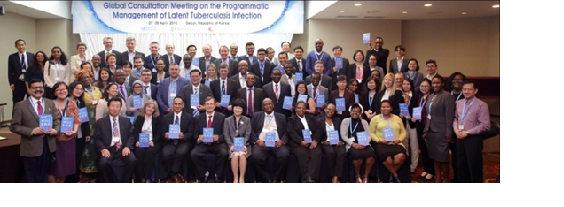First global consultation on latent TB infection and review of Korea’s TB programme
The Republic of Korea is ramping up efforts to tackle tuberculosis (TB) – a top infectious disease killer worldwide – as part of its plan to cut TB incidence by half between 2011 and 2020.
Despite being a high-income country, Korea still faces a considerable TB burden with about 43,000 people falling ill with TB and 2,000 people dying of the disease each year. Progress has been made over the past four years with TB incidence dropping by 4.5% each year, and declining mortality.
Highlights on the progress and challenges Korea has faced to tackle TB over the past few years were presented and discussed yesterday at a review meeting of Korea’s National TB Programme with the participation of WHO’s Global TB Programme and Regional Office for the Western Pacific.
“In order to eliminate TB in Korea, we are expanding our screening of those at high risk of TB and their families, and providing the necessary treatment,” said Dr Unyeong Go, Director of Center for Disease Prevention, Korea Centers for Disease Control and Prevention (KCDC). “Our TB elimination plan also includes ramping up TB information campaigns, strengthening the country’s health infrastructure, and investing in health personnel.”

“We can count on Korea to be a pathfinder towards TB elimination through their visionary and intensive efforts both to interrupt TB transmission by diagnosing early and treating all and to manage latent TB infection among vulnerable people,” said Dr Mario Raviglione, Director of WHO’s Global TB Programme.
Dr Nobuyuki Nishikiori, Coordinator, Stop TB and Leprosy Elimination Unit, WHO’s Regional Office for the Western Pacific, added: “Korea’s commitment to roll out access to TB preventive therapy should encourage other countries in the region to scale up efforts to effectively tackle latent TB infection.”
Following this meeting, WHO, KCDC and the International TB Research Center of Korea are holding the first-ever global consultation on large-scale management of latent TB infection (LTBI) in Seoul from 27 to 28 April. Over 100 TB experts from both high and low TB burden countries will discuss ways to best tackle latent TB infection in their countries with the ultimate goal of contributing to ending TB. They will identify best practices, challenges and opportunities in the implementation of programmatic management of LTBI. The research landscape for LTBI treatments will be addressed to identify potential impact and implementation gaps. And a monitoring and evaluation mechanism will be defined on the programmatic management of LTBI.
Screening those most at risk of TB is essential to determine if they have “latent TB” – which means they have been infected by the TB bacteria but are not yet ill with the disease and cannot transmit it. Those diagnosed with latent TB are then given TB preventive therapy for a period varying between three and nine months. The currently available treatment options reduce the risk of developing active TB disease by 60-90%. About one third of the world’s population (2-3 billion people) has latent TB infection – but the vast majority of them will never develop the disease during their lifetime.
The management of LTBI among high risk groups is a key component of the World Health Organization’s new End TB Strategy and is necessary to end the global TB epidemic and eliminate TB altogether. One of the Strategy’s global priority targets is achieving ≥90% LTBI treatment coverage among people living with HIV and children aged less than 5 years who are household contacts of a TB case.
“When it comes to ending TB, the good news is we now have a clear strategy adopted by health ministers on what needs to be done,” said Dr Mario Raviglione. “We are seeing significant momentum in many countries with governments and partners working together to pursue innovative ways to confront TB. It is inspiring to see how the Korean Government has made ending TB a top priority to ensure a healthy future for its population.”
